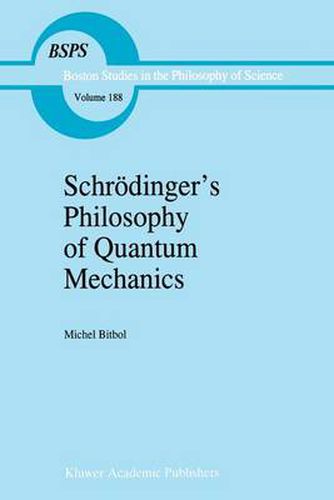Readings Newsletter
Become a Readings Member to make your shopping experience even easier.
Sign in or sign up for free!
You’re not far away from qualifying for FREE standard shipping within Australia
You’ve qualified for FREE standard shipping within Australia
The cart is loading…






This title is printed to order. This book may have been self-published. If so, we cannot guarantee the quality of the content. In the main most books will have gone through the editing process however some may not. We therefore suggest that you be aware of this before ordering this book. If in doubt check either the author or publisher’s details as we are unable to accept any returns unless they are faulty. Please contact us if you have any questions.
This text provides a comprehensive account of Erwin Schrodinger’s successive interpretations of quantum mechanics, culminating in their final synthesis in the 1950s. It should be of interest to scientists, historians and philosophers who are involved in the foundational problems of modern physics. The book shows that the widespread view, according to which Schrodinger was conservative in his approach to quantum mechanics, is ill-founded. A rational reconstruction of Schrodinger’s innovative interpretation of the quantum theory in the 1950’s is undertaken. His apparently conflicting attitudes towards realism (which combine Mach’s positivism and realism of theoretical entities) are reconciled in the framework of S. Blackburn’s quasi-realism . Schrodinger’s rejection of corpuscles, and his adoption of wave-like entities instead, is shown to be a by-product of his phenomenalist conceptions of material bodies and of his quasi-realist attitude towards theoretical entities. In addition, his views on the measurement problem are compared with current no-collapse interpretations (especially Everett’s and Van Fraassen’s). Finally, Schrodinger’s and Bohr’s positions are systematically contrasted. The difference between Bohr’s combination of holistic and dualistic analysis of the measurement process (contextual phenomena combined with classical-quantum cut), and Schrodinger’s parallelist conception (experimental events - wave function evolution) is emphasized.
$9.00 standard shipping within Australia
FREE standard shipping within Australia for orders over $100.00
Express & International shipping calculated at checkout
This title is printed to order. This book may have been self-published. If so, we cannot guarantee the quality of the content. In the main most books will have gone through the editing process however some may not. We therefore suggest that you be aware of this before ordering this book. If in doubt check either the author or publisher’s details as we are unable to accept any returns unless they are faulty. Please contact us if you have any questions.
This text provides a comprehensive account of Erwin Schrodinger’s successive interpretations of quantum mechanics, culminating in their final synthesis in the 1950s. It should be of interest to scientists, historians and philosophers who are involved in the foundational problems of modern physics. The book shows that the widespread view, according to which Schrodinger was conservative in his approach to quantum mechanics, is ill-founded. A rational reconstruction of Schrodinger’s innovative interpretation of the quantum theory in the 1950’s is undertaken. His apparently conflicting attitudes towards realism (which combine Mach’s positivism and realism of theoretical entities) are reconciled in the framework of S. Blackburn’s quasi-realism . Schrodinger’s rejection of corpuscles, and his adoption of wave-like entities instead, is shown to be a by-product of his phenomenalist conceptions of material bodies and of his quasi-realist attitude towards theoretical entities. In addition, his views on the measurement problem are compared with current no-collapse interpretations (especially Everett’s and Van Fraassen’s). Finally, Schrodinger’s and Bohr’s positions are systematically contrasted. The difference between Bohr’s combination of holistic and dualistic analysis of the measurement process (contextual phenomena combined with classical-quantum cut), and Schrodinger’s parallelist conception (experimental events - wave function evolution) is emphasized.